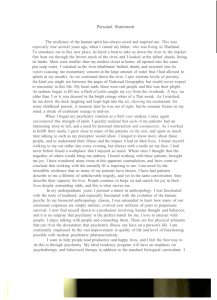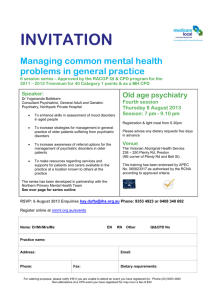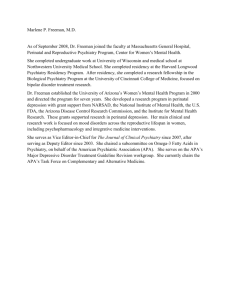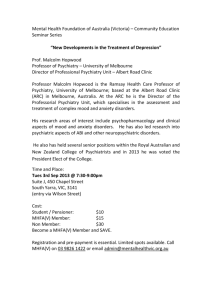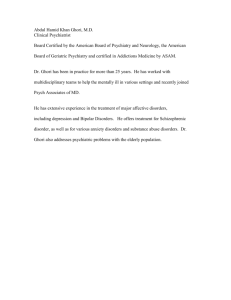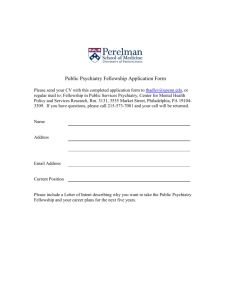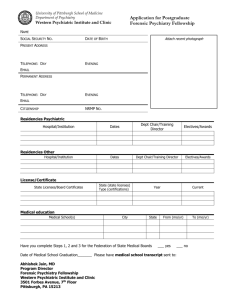William (“Bill”) McKinney was raised in a small town in Georgia, the
advertisement
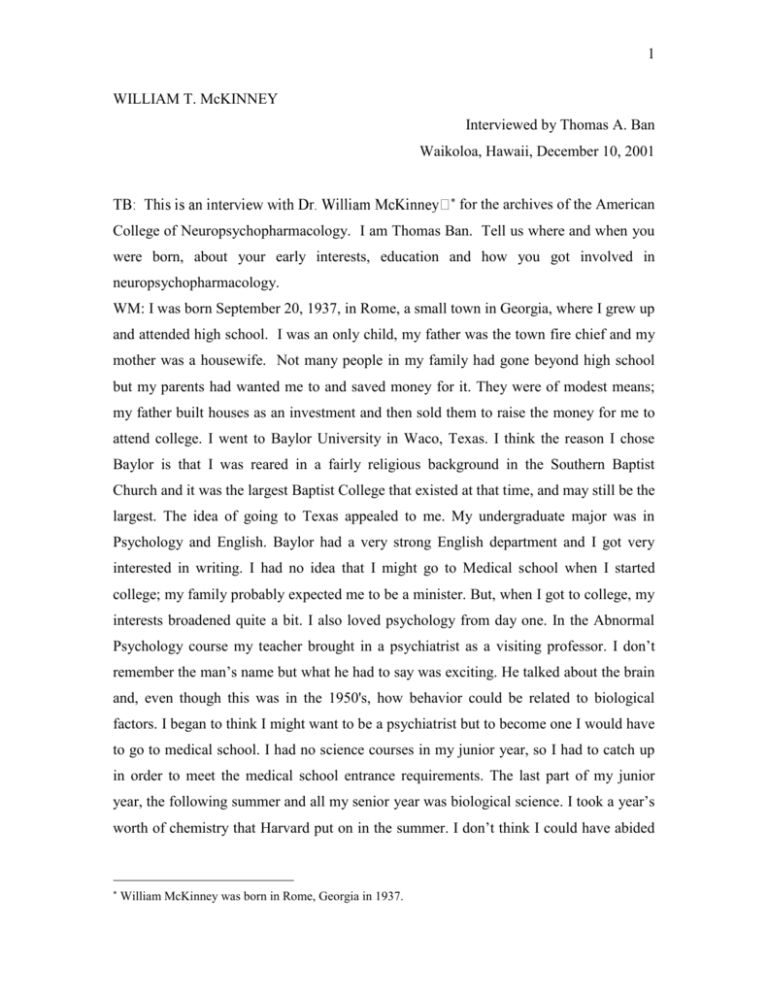
1 WILLIAM T. McKINNEY Interviewed by Thomas A. Ban Waikoloa, Hawaii, December 10, 2001 for the archives of the American College of Neuropsychopharmacology. I am Thomas Ban. Tell us where and when you were born, about your early interests, education and how you got involved in neuropsychopharmacology. WM: I was born September 20, 1937, in Rome, a small town in Georgia, where I grew up and attended high school. I was an only child, my father was the town fire chief and my mother was a housewife. Not many people in my family had gone beyond high school but my parents had wanted me to and saved money for it. They were of modest means; my father built houses as an investment and then sold them to raise the money for me to attend college. I went to Baylor University in Waco, Texas. I think the reason I chose Baylor is that I was reared in a fairly religious background in the Southern Baptist Church and it was the largest Baptist College that existed at that time, and may still be the largest. The idea of going to Texas appealed to me. My undergraduate major was in Psychology and English. Baylor had a very strong English department and I got very interested in writing. I had no idea that I might go to Medical school when I started college; my family probably expected me to be a minister. But, when I got to college, my interests broadened quite a bit. I also loved psychology from day one. In the Abnormal Psychology course my teacher brought in a psychiatrist as a visiting professor. I don’t remember the man’s name but what he had to say was exciting. He talked about the brain and, even though this was in the 1950's, how behavior could be related to biological factors. I began to think I might want to be a psychiatrist but to become one I would have to go to medical school. I had no science courses in my junior year, so I had to catch up in order to meet the medical school entrance requirements. The last part of my junior year, the following summer and all my senior year was biological science. I took a year’s worth of chemistry that Harvard put on in the summer. I don’t think I could have abided William McKinney was born in Rome, Georgia in 1937. 2 it for a whole year. I completed all the requirements in my senior year and applied to medical school so that I could become a psychiatrist. TB: It seems the psychiatrist your teacher brought in as visiting professor had a great impact on your future even though you don’t remember his name? WM: I don’t. But I do recall he was from a private practice setting in the area. TB: So he was a practicing psychiatrist? WM: He talked to us about the patients he saw and what his work was like. I was totally taken by it. At the time I applied to medical school I had completed very few biological science courses and was still in the middle of catching up. I didn’t want to wait another whole year, so I took the Medical College Admissions Test, and my scores were widely split, not surprisingly. They were very high in the verbal part and low in biological science. Some medical schools wanted to know more about me and others would look at the numbers and decide “No way”. I was accepted and turned down by some very good medical schools but ended up deciding to go to Vanderbilt, which is only a few hours from my home town. There were just fifty-two students in our entering class. TB: What year was that? WM: I graduated from college in 1959, and started medical school that fall and graduated in 1963. During medical school, I changed my mind a few times about what I wanted to do, but I think there was a guiding stream throughout. I found myself migrating to psychiatric journals in the library when I had spare time. I enjoyed a lof other things and came very close to going into neurology. There was a superb neurology teacher at the time, Charles Wells. He was head of neurology when I was a medical student and we wrote a paper together. TB: What was it on? WM: It was a historical paper about the Civil War, Weir Mitchell and neurasthenia. TB: So, you did your first paper with Charles Wells on neurasthenia? WM: I did my residency from 1964 to 1966 in Chapel Hill and, during that time, Charles decided to go into psychiatry himself and moved to do his psychiatry residency to Duke. TB: At the time you did your paper with Charles, who was the chairman of psychiatry at Vanderbilt? 3 WM: William Orr. He was very influential and a wonderful teacher who taught the first two year courses although, in the second year, we also had small groups in which we started to learn psychopathology and the different syndromes, taught by Frank Luton. TB: Frank Luton, a great man. WM: A wonderful teacher. I had great teachers in psychiatry and neurology, throughout my medical student time. Frank Luton, William Orr and Charles Wells, were on the front lines in terms of teaching and available to talk to us as students. TB: Did you stay in contact with Charles Wells? WM: We kept in touch. TB: Are you still in contact with him? WM: Not now, it’s been awhile. But we’ve kept in touch over the years. TB: What about Frank Luton? WM: My memories of Frank are of sitting around a table with him in the conference room, going through the different syndromes and interviewing patients. We’d see people with different types of disorders and he was a very wise, wonderful man. It was a very positive experience to be exposed to him and to Bill Orr. Later, it was a real privilege to be asked by Mike Ebert to come back to Vanderbilt to give the first William Orr memorial lecture. I don’t know how he got anything done in administration because he was always there for us and always very warm and interested. He was just a fascinating man. TB: So you were taught psychodynamic psychiatry. Bill Orr was a psychodynamically oriented psychiatrist. Frank Luton was trained at Hopkins by Adolf Meyer. . WM: Yes, and we learned Adolph Meyer’s way of thinking about psychopathology, early on. Charting life events and integrating those with temperament and genetic traits. Some of the things we now think of as new, Frank Luton was teaching me when I was a medical student. I’ll never forget the first patient in my clinical psychiatry rotation. I was out at Central State Hospital near Nashville. He had catatonic schizophrenia of the kind where the patient didn’t move, didn’t talk and was mute. Frank and Bill Orr taught us to respect the patient’s need for distance and predictability. You’re respectful, not too demanding, but just there. They’ve got their space and you don’t encroach on it. I would ask him if he wanted to talk or say anything but I wouldn’t push too hard. I would just 4 show my interest and might be there ten minutes or go away and come back another day. Weeks passed and he didn’t say a thing. Finally, toward the end, the patient started to talk. I’ll never forget that. TB: That was a great experience. WM: And, internal medicine was taught well too. Grant Willow was my endocrinology teacher. He was a great lecturer, very clear and a cutting edge clinician. I graduated there in 1963 and had made the decision to go into psychiatry, but in1963, one had to do a twelve months internship in something else. So, I did a full twelve months in internal medicine, a specialty I liked as a student. I did that at Bowman Gray Medical School in Winston Salem, and that was a good year. It was my first experience having front line responsibility for patient care. It was just about the time time that they were stopping to do insulin therapy. TB: Were they using modified insulin? WM: No, the deep coma. They were doing it when I was an intern. We looked after also some of the patients when they were given sub-coma insulin. TB: Was this in the mid sixties? WM: July of 1963 through June of 1964. TB: For what indication did they you use it? WM: For some forms of anxiety, and some forms of schizophrenia. TB: Insulin coma therapy for schizophrenia was lingering on. WM: In July of 1964, I started my psychiatry residency at the University of North Carolina in Chapel Hill. During my senior year in medical school, I had some elective time, and I spent it with Art Prange at Chapel Hill. I did my first research project with Art. Morey Lipton was still there. TB: What did you study with them? WM: We published a paper called The Achilles Reflex in an Unselected Psychiatric Population. TB: That’s interesting. WM: Art was getting interested in the thyroid and one measure of thyroid function was the Achilles Reflex. You tapped a person’s ankle and it had break, a beam of light. The reflex was recorded on paper which measured the time it took. We found that in a non- 5 selected group of inpatients, those who were suffering from depression tended to have slower ankle reflexes, as a group. TB: So, you found that depressed patients had slower ankle reflexes? WM: Yes. There was another experience I had as a medical student that was relevant to my subsequent career. I spent a summer, between my sophomore and junior year, working in the Preventive Medicine Public Health Department as an apprentice with a bio-statistician. He was doing consultations with faculty members on the design of their projects. When the study was done, they would do the data analysis. That was wonderful training in design and methodology issues. TB: Both these research experiences as a medical student provided a groundworkyou’re your residency. WM: Yes. In 1964 Chapel Hill was a very active place with a lot of good faculty and residents whose names you’d probably recognize, in the field. TB: Can you name some of them? WM: In my class were, Fred Goodwin, Bruce Green, Peter Whybrow, Lynn Dailey, David Markot and Ali Jahre, who was from Saudi Arabia. I’m leaving two or three out, but I can picture them. TB: That’s fine. WM: And a year ahead of us, were Wyatt McCurdy, Albert Allen Wood and Joe Mandels, all I think, active in psychopharmacology. TB: Was Morey Lipton the Chairman of the department? WM: Morey was a senior research faculty member; the Chairma was George Hamm. George Hamm had come from Chicago to start the department at Chapel Hill. George was a psychoanalyst, and brought some other people with him. They had a series of acting Chairs during the time I was a resident. Morey was running and helping the research programs in the department. He was very important in my development, as a good advisor and senior mentor, as was Art. As a resident I knew early on I wanted to do combined clinical and animal research and they really helped me do both for two years before I transferred to Stanford for my third year because I wanted to see a different part of the country while I was single. I didn’t leave out of dissatisfaction but for personal reasons. Stanford was very good, David Hamburg was Chair, and a lot was going on 6 there. In 1966-1967 I did my third year of residency and met my wife. We were married in 1967 and have been married ever since. That was a good year. California was like a whole new world for me and I remember a number of things about that year. A lot of people associated Stanford with research at that time, and that was true. They had good clinicians and researchers. I was able to arrange a consultation with David Hamburg about career development. He seemed very glad to meet and talk with me and advised me about a variety of issues. I finished my residency and, up to this moment, I had not done any primate research. TB: What did you do after your residency? WM: That’s when I went to NIH for two years and from 1967 to 1969 I was at the National Institute of Health, and worked part-time with William Bunney who was branch chief. It was a very exciting time, because they started to use the new rating scales on their inpatients on the ward. This whole concept of doing clinical research and the way they were doing it, in a control setting was very exciting. Biff Bunney put me on to the path of depression research, but I didn’t quite know what aspect until he suggested the animal models of depression. He had not published in that area and was too busy with other things to tackle it. There were a number of things in the literature that had never been brought to bear in an explicit way on this topic. One of the people whose work I was very interested in was Harry Harlow. I had known about his work as an undergraduate psychology student so I wrote and asked if I could have some of his time. He was president of the American Psychological Association, with a long series of honors, but he wrote me a very thoughtful letter about the directions I might think about, including primate work. I began thinking that’s the direction I want to go into and learn how to do animal research. Meanwhile, at Bethesda I ran into Doug Bowden, who was in the Institute of Neurological Diseases, and had a primate laboratory. So he and I started to do my first real primate project at NIH in the intramural program. That was a study in which we looked at the separation responses of rhesus monkeys with different types of frontal lobe lesions compared to intact animals and found that they were much more sensitive to the separation with more dramatic effects that lingered longer. It was an interesting project. In the Public Health Service, during those two years in Washington, I 7 was also working in a psychiatry training branch at Bethesda involved in NIMH training grant review committees. TB: When did you move to Wisconsin? WM: I went to Wisconsin to work in the Primate Center and joined the faculty in July 1969. I could have gone to a couple of other places that had primate centers, but I found the psychiatry department in Wiscosin very different and interesting. The Chair was Milton Miller. I like Milt a lot. He’s a very caring person and thoughtful administrator. It’s a nice combination. It was also a very strong clinical psychiatry department at that time. All of all that, with the primate center and Harry Harlow being there, was what attracted me. I also liked Madison, the town, so I wound up there. When I started, the primate center lab didn’t have an office for a psychiatrist, so Harry, this world famous psychologist, invited this brand new faculty member to share his big office. I shared it for maybe a year or so. Harry was always prey to people, coming in to talk to him, but it was very rarely that he asked me to leave. That was a real growth experience. TB: So your interest in primate work started while working with Biff Bunney looking for animal models of depression? WM: Yes, absolutely. I knew I was interested in some type of depression research. When I got to NIH, after finishing my residency, Biff challenged and stimulated me to look for animal models and to think about opening that up as a research area. He deserves full credit for that. He and I wrote one of the first papers called Animal Models of Depression in which we charted out some of the criteria and how to go about developing models and criteria for evaluating them. He and I wrote that article around 1969 and I think it was published in the Archives. Biff stimulated me in the general area of animal models and Harry provided me an infrastructure and a setting in which I could learn to do primate research and think about behavior in a developmental sense. Harry was interested in building on the work he had done over many years, starting first with learning, based on the cognitive work developed with the Wisconsin General Testing Apparatus. From there we went to the relevant social attachment systems, to disruption of attachment systems and then to separation studies. He was interested in extending it into biological areas, but it wasn’t quite his thing to link it up with psychopathology. So, the timing was good, because I was able to help him with that and he certainly helped me in providing an 8 infrastructure in terms of learning how to do primate research. There was a lot going on there at the time and it was a very exciting place to be. TB: Are we now in the mid-1970s? WM: I arrived at Wisconsin in 1969 and over the first five or six years we got my primate research program going. TB: Could you say something about the primate research you did? WM: I had to learn the techniques of doing primate research, how to develop and utilize different types of rating scales, how to work with the animals and what kind of biological and drug studies one could do in primates. I also had to think through where primates fit in the spectrum of different approaches. I’d been intrigued early on by the literature that was starting to emerge about the role of early experience in shaping behavior and influencing neurobiological development, across the life span. It was in Harlow’s group that some of the findings in this area of research came from. There are four or five other people who have documented effects of early isolation on biological and behavioral development. I was interested in that, so that’s an area I started with. We worked with animals who had been socially deprived and then tried to find ways to reverse it. We tried chlorpromazine in some monkeys and it reduced the large array of abnormal behaviors they displayed. When we stopped the medication abnormal behaviors came back. We didn’t have a variety of different neuroleptic agents as we have now to study. Later on we tried antidepressants in some of the separation paradigms, too. TB: Which paradigm did you work with? WM: I was working with the isolation and the separation paradigm. TB: So, you worked with both paradigms? WM: Yes. In the isolation paradigm, we were involved in studies showing that a neuroleptic was effective in reversing all the abnormal behaviors; benzodiazepines were not. TB: So the reversal worked with chlorpromazine? WM: It did. TB: Could you see the effects of separation on individual monkeys? 9 WM: Not individually. If you make social isolation severe enough you start to minimize the variation although you don’t do away with it. The more severe you make it the less individual variation there will be. Just like an extremely traumatic event. TB: What would chlorpromazine actually do? WM: It would reduce a lot of the abnormal behaviors that the animals would show as a result of the early experience. We also found, in collaboration with Harlow, that you could treat these animals by providing them social experience with younger peers. We did more recent work through the MacArthur Foundation showing how early experience got effects in a lot of domains, including neuroanatomical changes. We did this later work in collaboration with a group in New York at Mount Sinai involving John Morrison and Steve Siegel. We demonstrated for the first time that early isolation experiences could have significant cytoarchitectural effects in the hippocampus. I don’t think many people knew quite what to make of that but the finding was solid and clear. Subsequent work in a variety of early stress paradigms has replicated and expanded this initial finding. In collaboration with Gary Kramer, a student in my group, we demonstrated that if you took socially isolated animals and rehabilitated them so they looked normal, and then you challenged them with a low dose amphetamine, they were hypersensitive to it, as opposed to animals that had not been in social isolation. They became hyperaggressive; even lethally hyper-aggressive. So the early experience was only seemingly reversed. They were carrying scars of vulnerability, based on their early experience, and if you challenged it, you could bring it out. Finally, maybe I’ll talk about the separation paradigm. Harlow and two or three other labs had already shown that by separating rhesus monkeys from their mother, you get a biphasic protest-despair response, which show significant similarities to descriptions of human infants. I did a series of studies focusing on the pharmacological aspects. I studied imipramine first and it worked. If it doesn’t work right away, you had to take them through a couple of cycles, but imipramine can block the separation response. We’ve recently shown that fluoxetine does the same thing. Antianxiety drugs can influence the initial response but don’t block the total depressive responses that occur after separation. TB: Did you try desipramine? WM: We did do desipramine.. 10 TB: What about MAOIs? WM: That’s a good question .we don’t know whether an MAOI would do it or not. TB: What about meprobamate? WM: Meprobamate has not been tried, to my knowledge. TB: What about diazepam? WM: It doesn’t work. The studies take a while to do, they’re not so simple. TB: You started to work with the separation model in the 1970‘s and are still using it? WM: Yes. In 1993, I moved to Northwestern to start a research and treatment center. I wasn’t really looking to move, but this was a good opportunity. TB: Before moving onto that, am I correct that you were at a certain point Chairman of the Department of Psychiatry at the University of Wisconsin. When was that? WM: I was department Chair from 1975 to 1980. TB: But, even while you were chairman, you continued your research? WM: Yes. I liked being Chair anddid not dislike the administration. I didn’t leave it for that reason, but realized I couldn’t do everything and decided to focus on research, teaching and clinical work. I had accepted a Dow Chair at Northwestern to start this Center. It was a new challenge. TB: Could you say something about the Center? WM: The overall charge is to be multidisciplinary, dedicated to understanding the diagnosis and treatment of depressive disorders. We have a basic division and a clinical division and the basic division is heavily oriented toward, behavioral neurosciences. We have four or five basic neuroscientists in the basic science division and a clinical mood disorder program with five psychiatrists involved and an administrative person. We have a small primate operation focused on circadian biology issues. I’m collaborating with a neuropharmacologist, Dr. Dubocovich, and there’s also a strong circadian biology group on the Evanston Campus, looking at melatonin receptors. TB: So you are looking at melatonin receptors? WM: Collaborating with the neuropharmacologist, looking at melatonin receptor subtypes she has characterized in other species. She’s looking at different agonists and antagonists through the different melatonin receptor subtypes, and characterizing the effects they have on circadian biology disturbances in primates. Three or four people at 11 the basic science level are looking at different types of gene expression and working at the molecular neuroscience level. The Center ranges from scientists working at the molecular neuroscience level to clinicians doing clinical trials. TB: Do you have an outpatient clinic to treat patients? WM: Primarily outpatients, although people in the program will work on the inpatient service, if patients need to be hospitalized. TB: Do you have a certain number of hospital beds? WM: The department has its own service and we can admit someone as long as they’re beds available. TB: Are you having both unipolar and bipolar patients? WM: It not designated bipolar and unipolar; it’s defined as mood disorders. TB: Mood disorders? WM: We see bipolar and unipolar patients and people with major comorbidities. We are not an anxiety disorders program but anxiety disorders comorbid with depressive disorders are fine. We also see people with substance abuse problems and mood disorders. TB: Could you say something about the ongoing clinical research in the center? WM: I’d have to add them up. We’re one of the regional centers for the Star D study. We’re also a regional center for the KD schizophrenia and KD Alzheimer’s studiees. .We’re involved in the TADS, adolescent depression project, with a psychologist named Mark Reineke, who is the Principal Investigator (PI). We are one of the sites for ancillary studies from STAR D to Child STAR D. TB: Can you tell us what STAR D means and something about the study? WM: STAR D means Sequence Treatment Alternatives to Relieve Depression and this is an NIH funded, multi-site study, with John Rush and Madhukar Trivedi, a PI at the University of Texas. There are fourteen regional centers around the country and we’re one of those. One of the ancillary studies to that is a Child STAR D and there are five or six centers in that study. TB: So you are very active. WM: Very active. It’s been a good move; a new challenge at this phase of my life and I’m glad I did it. 12 TB: How much of your time is spent in clinical, how much in teaching and how much in research? WM: Probably a ten-hour day, seeing patients during a week. .And, then, of course, there are add-ons to that. TB: So you spend at least one fifth of your time seeing patients? WM: At lease one fifth of my time seeing my own patients and I see other patients in the context of some of the studies and trials. TB: How much teaching? WM: Teaching varies. I teach a journal club to our residents and organize the neurobiology seminar series. I teach in that series, organize it and get other neuroscientists from around the place to help teach the residents. TB: How much time does that mean? WM: Probably about half-time and about half-time. I’ve always felt strongly about maintaining my own patients. TB: What would you consider your most important contribution? WM: From a research standpoint, I think developing the concepts of animal models in the field of psychiatry and laying out the groundwork and framework for a series of studies that have since been expanded by others in a variety of different directions. It was really a major move in terms of opening up that whole area for the field. I’ve trained people over the years and I feel good about that. TB: Would you like to name some of the people you trained? WM: Hagop Akiskal was a resident of mine. Nick Kalen came to Wisconsin when I was on the faculty and did his first primate work with me. Akiskal came to me as a third year resident and transferred into our program to think through ways to approach research in depression. Akiskal has, obviously, blossomed. He’s editor of the Journal of Affective Disorders; he just got the NARSAD Award this year in the Affective Disorders area. There’s a number of clinicians I’ve been involved in training. They’re in various practice settings, some academic and some private settings around Wisconsin and I’ve watched the leadership roles they’ve taken over the years. I feel very good about that. Gary Kramer, a graduate student of mine, is now a tenured faculty member at Wisconsin. We trained a half dozen or so people who have gone on to various kinds of careers in the 13 field. I feel good about one of our chief residents in Wisconsin, Randy Thompson, who is now down in Chicago heading up one of the major hospitals. I, also, feel good about the fact I have not stayed in the lab all the time. I’ve done other things. For example, I’ve been Director on the American Board of Psychiatry and Neurology for eight years and just finished up my rotation. That was a very time consuming job, but I felt strongly about staying active in the field of psychiatry. I, also, tried to keep a personal life through all this. TB: Would you like to talk about that? WM: I have other interest besides my work. There’s absolutely no way I could have achieved what I have without the support of my wife Carolyn and my children, who tolerated a lot. The things I’ve described take a lot of time, in travel. My family has been very supportive, so I feel really good about that. My son, Scott, who is twenty-nine, is married to Kristin and I have a daughter, Julia, she’s twenty-five, who lives and works in Houston. I’ve tried to keep my priorities straight over the years. I’ve got interested in running and I’ve become a runner. TB: A runner? WM: Yes, not racing, just jogging and running. I’ve been running all my life. I think I’ve done eleven marathons now. I started that when I was fiftyish. TB: That’s great! What was your last paper? WM: Gary Tucker called and asked me if I would edit a special issue of the journal that he’s the overall editor in Seminars in Neuropsychiatry. He wanted to do a special issue on Stress and Affective Disorders and asked me if I would be the guest editor and write an article for it. I did the editing, rounding up everyone to write the papers, wrote an introduction and an article myself on Stress, Animal Models and Depression. TB: You have been involved with ACNP for approximately twenty years. WM: A little bit more than that now. TB: Have you served on any of the committees? WM: I’ve been on committees. I’ve been active. The meetings are at a difficult time of the year, in terms of family life and the things we value as a family. I’ve tried to come to meetings but I’ve missed some. I’m on the education and training committee now; I’ve 14 been on the committee that deals with advocacy groups and I’m joining the animal committee, starting in 2002. TB: Have you written any books? WM: I’ve written two. TB: What are they? WM: One called Animal Models in Mood Disorders that I wrote myself and the other called, Mood Disorders: Towards A New Psychobiology, is written by me, Peter Whybrow and Hagop Akiskal. TB: When were they published? WM: In the late eighties. TB: Is there anything important we did not cover? WM: As a junior faculty member when I had a research career at NIMH I was able to put together a sabbatical with Robert Hind in Cambridge, so that was really important. And, then, in the mid eighties, I was a Fellow up at the Center for Advanced Behavioral Sciences at Stanford for a year and that was also a very good, important year. TB: Is there anything else you would like to add? WM: I think this is a very exciting time for the field right now. So many new developments are going on. I would like to see basic and clinical developments, to see these domains stay in touch with each other. The areas are getting so specialized that to do it on an individual basis can be awfully hard. One person can no longer bridge this any more. We’ve got to think through new ways for it to happen, for the interaction to occur. This is where I think the College has played an increasingly important role, because you’ve got in the same organization, clinician researchers and highly skilled basic neuroscience researchers. Things have changed so much that we’ve got to find other structures to help to do this. TB: On this note we should conclude this interview. Thank you very much. WM: Thank you.
